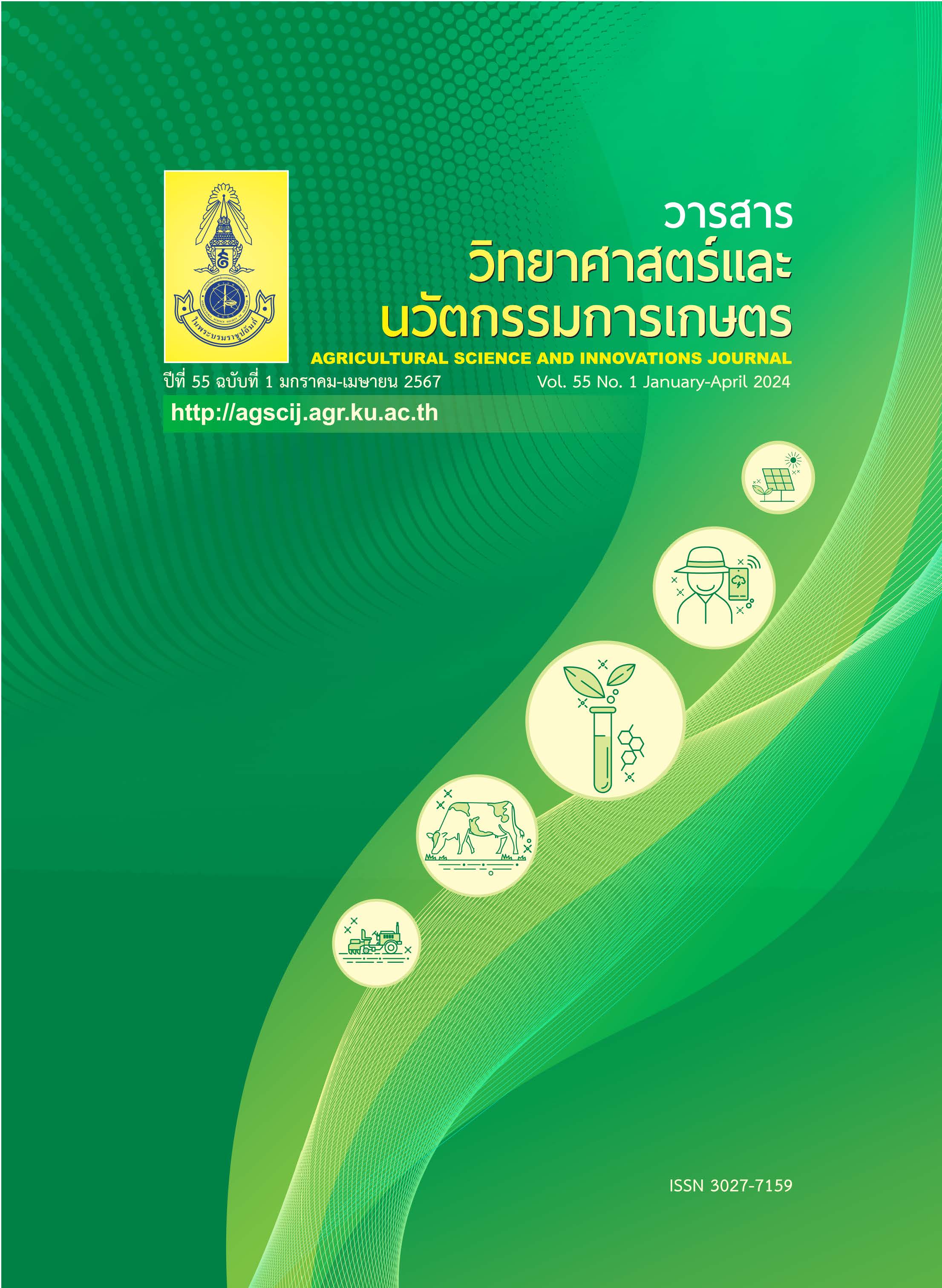การประเมินความอุดมสมบูรณ์ดินด้วยแบบจำลองการประมาณค่าเชิงพื้นที่ของดินที่ได้รับผลกระทบจากเกลือในตำบลเมืองเพีย อำเภอบ้านไผ่ จังหวัดขอนแก่น
Main Article Content
บทคัดย่อ
ความเป็นมาและวัตถุประสงค์: การประเมินระดับความอุดมสมบูรณ์ของดินที่ได้รับผลกระทบจากเกลือในพื้นที่ขนาดใหญ่มีข้อจำกัดด้านเวลา กำลังคน และงบประมาณในการวิเคราะห์ดิน การใช้แบบจำลองการประมาณค่าเชิงพื้นที่ร่วมกับการทำแผนที่ดิจิทัล เพื่อประเมินระดับความอุดมสมบูรณ์ของดินเป็นเครื่องมือสำคัญสำหรับการคาดการณ์สมบัติดิน ติดตามระดับความอุดมสมบูรณ์ของดินที่ได้รับผลกระทบจากเกลือเชิงพื้นที่ได้อย่างรวดเร็ว และเป็นฐานข้อมูลสำหรับการจัดการดินที่ได้รับผลกระทบจากเกลือได้อย่างเหมาะสม แต่ยังขาดการพัฒนาแบบจำลองให้มีความแม่นยำและถูกต้อง การศึกษานี้จึงมีวัตถุประสงค์เพื่อศึกษาการประมาณค่าเชิงพื้นที่ด้วยแบบจำลอง Random Forest (RF) เพื่อการคาดการณ์การกระจายของสมบัติดิน และประเมินความอุดมสมบูรณ์ดินในพื้นที่ดินที่ได้รับผลกระทบจากเกลือในกลุ่มดินย่อย Typic Natraqualfs ในตำบลเมืองเพีย อำเภอบ้านไผ่ จังหวัดขอนแก่น
วิธีดำเนินการวิจัย: เก็บตัวอย่างดินที่ได้รับผลกระทบจากเกลือ กลุ่มดินย่อย Typic Natraqualfs ในตำบลเมืองเพีย อำเภอบ้านไผ่ จังหวัดขอนแก่น จำนวน 100 บริเวณ โดยเก็บตัวอย่างดินที่ระดับความลึก 0–30 เซนติเมตร และวิเคราะห์ปริมาณอินทรียวัตถุ ปริมาณฟอสฟอรัสและโพแทสเซียมที่เป็นประโยชน์ ความจุแลกเปลี่ยนแคตไอออน ค่าร้อยละความอิ่มตัวเบส และค่าการนำไฟฟ้าของสารละลายที่สกัดจากดินอิ่มตัวด้วยน้ำกลั่น (ECe, อีซีอี) และนำเข้าตัวแปรเหล่านี้ในแบบจำลองการประมาณค่าเชิงพื้นที่เพื่อคาดการณ์การกระจายเชิงพื้นที่ของสมบัติดิน ร่วมกับตัวแปรทำนาย คือ แบบจำลองระดับความสูงเชิงเลข (DEM) และข้อมูลจากภาพถ่ายดาวเทียม Landsat 8 แล้วทำการประเมินระดับความอุดมสมบูรณ์ดินในพื้นที่ศึกษา
ผลการวิจัย: แบบจำลอง RF สามารถคาดการณ์การกระจายเชิงพื้นที่ของสมบัติดินได้ดีด้วยค่าสัมประสิทธิ์ของการตัดสินใจ (R2 = 0.41–0.82) แต่แบบจำลองมีค่าความคลาดเคลื่อนสูงในการประมาณค่าปริมาณฟอสฟอรัสที่เป็นประโยชน์ ปริมาณโพแทสเซียมที่เป็นประโยชน์ และอีซีอี ผลการประเมินความอุดมสมบูรณ์ดินที่ระดับความลึก 0–30 เซนติเมตร พบว่า กลุ่มดินย่อย Typic Natraqualfs ในพื้นที่การศึกษามีความอุดมสมบูรณ์อยู่ในช่วงระดับต่ำถึงปานกลาง
สรุป: แบบจำลอง RF มีความแม่นยำในระดับที่สามารถนำไปใช้ในการคาดการณ์การกระจายเชิงพื้นที่ของสมบัติดินเบื้องต้น และสามารถใช้ประเมินความอุดมสมบูรณ์ดินที่ได้รับผลกระทบจากเกลือได้อย่างมีประสิทธิภาพ
Article Details

อนุญาตภายใต้เงื่อนไข Creative Commons Attribution-NonCommercial-NoDerivatives 4.0 International License.
เอกสารอ้างอิง
Bray, R.H. and L.T. Kurtz. 1945. Determination of total, organic, and available forms of phosphorus in soils. Soil Sci. 59(1): 39–46.
Chaplot, V., M. Bernoux, C. Walter, P. Curmi and U. Herpin. 2001. Soil carbon storage prediction in temperate hydromorphic soils using a morphologic index and digital elevation model. Soil Sci. 166(1): 48–60.
Copernicus, D.E.M. 2022. OpenTopography datasets. Available Source: https://doi.org/10.5069/G9028PQB, March 20, 2022.
Dharumarajan, S., R. Hegde and S.K. Singh. 2017. Spatial prediction of major soil properties using Random Forest techniques - A case study in semi-arid tropics of South India. Geoderma Reg. 10: 154–162. https://doi.org/10.1016/j.geodrs.2017.07.005.
FAO (Food and Agriculture Organization of the United Nations). 2020. Country Guidelines and Specifications for Mapping Salt-affected Soils. Rome, Italy. 131 p.
Fathizad, H., M.A.H. Ardakani, H. Sodaiezadeh, R. Kerry and R. Taghizadeh-Mehrjardi. 2020. Investigation of the spatial and temporal variation of soil salinity using random forests in the central desert of Iran. Geoderma. 365: 114233. https://doi.org/10.1016/j.geoderma.2020.114233.
Gorji, T., A. Yildirim, E. Sertel and A. Tanik. 2019. Remote sensing approaches and mapping methods for monitoring soil salinity under different climate regimes. Int. J. Envir. Geoform. 6(1): 33–49. https://doi.org/10.30897/ijegeo.500452.
Grimm, R., T. Behrens, M. Märker and H. Elsenbeer. 2008. Soil organic carbon concentrations and stocks on Barro Colorado Island — Digital soil mapping using Random Forests analysis. Geoderma. 146(1–2): 102–113. https://doi.org/10.1016/j.geoderma.2008.05.008.
Jansom, S., R. Katawatin and K. Pannangpetch. 2012. Some important chemical properties of salt-affected soils in Khon Kaen province. Khon Kaen Agr. J. 40(Suppl.): 259–263. (in Thai)
Jiang, Y., L. Zhang, B. Zhang, C. He, X. Jin and X. Bai. 2016. Modeling irrigation management for water conservation by DSSAT-maize model in arid northwestern China. Agric. Water Manag. 177: 37–45. https://doi.org/10.1016/j.agwat.2016.06.014.
Jolliffe, I.T. and D.B. Stephenson. 2003. Forecast Verification: A Practitioner’s Guide in Atmospheric Science. John Wiley & Sons Ltd., West Sussex, England.
Khongnonglan, T. 2013. Distribution and Variability of Kula Ronghai Series in Khorat Basin. MS Thesis, Kasetsart University, Bangkok. (in Thai)
Ku, H.H., J.H. Ryu, H.S. Bae, C. Jeong and S.E. Lee. 2019. Modeling a long-term effect of rice straw incorporation on SOC content and grain yield in rice field. Arch. Agron. Soil Sci. 65(14): 1941–1954. https://doi.org/10.1080/03650340.2019.1583330.
Land Development Department. 2018. 20-Year Soil Resource Management Plan in Thailand (2018-2037). Ministry of Agriculture and Cooperatives, Bangkok, Thailand. (in Thai)
Land Development Department. 2022. ID Din Dee. Available Source: http://iddindee.ldd.go.th/SoilSeries/home.html, January 22, 2023. (in Thai)
McBratney, A.B., M.L. Mendonça-Santos and B. Minasny. 2003. On digital soil mapping. Geoderma. 117(1–2): 3–52. https://doi.org/10.1016/S0016-7061(03)00223-4.
Norkaew, S. 2006. Variability of Natural Soil System as Affected by Salinity Level of Kula Ronghai Series in Roi Et Province. MS Thesis, Kasetsart University, Bangkok. (in Thai)
Pratt, P.E. 1965. Potassium, pp. 1022–1030. In C.A. Black, ed. Methods of Soil Analysis. Part 2. Chemical and Microbiological Properties. Agronomy No. 9. American Society of Agronomy, Inc., Madison, Wisconsin, USA.
QGIS Development Team. 2022. QGIS Geographic Information System. QGIS Association. Available Source: https://www.qgis.org, September 19, 2022.
R Core Team. 2022. R: A Language and Environment for Statistical Computing. R Foundation for Statistical Computing, Vienna, Austria.
Rezayati, S., M. Khaledian, T. Razavipour and M. Rezaei. 2020. Water flow and nitrate transfer simulations in rice cultivation under different irrigation and nitrogen fertilizer application managements by HYDRUS-2D model. Irrig. Sci. 38: 353–363. https://doi.org/10.1007/s00271-020-00676-1.
Richards, L.A. 1954. Diagnosis and Improvement of Saline and Alkali Soils. United States Salinity Laboratory, United States Department of Agriculture, Washington, D.C., USA.
Soil Resources Survey and Research Division. 2020. Soil Fertility Map in Khon Kaen Province. Land Development Department, Ministry of Agriculture and Cooperatives, Bangkok, Thailand. (in Thai)
Soil Survey Division. 1980. Handbook for Land Suitability Classification for Cash Crops. Land Development Department, Ministry of Agriculture and Cooperatives, Bangkok, Thailand. 76 pp. (in Thai)
Srisomkiew, S., M. Kawahigashi and P. Limtong. 2021. Digital mapping of soil chemical properties with limited data in the Thung Kula Ronghai, Thailand. Geoderma. 389: 114942. https://doi.org/10.1016/j.geoderma.2021.114942.
Sumner, M.E. and W.P. Miller. 1996. Cation exchange capacity and exchange coefficients, pp. 1201–1229. In D.L. Sparks, A.L. Page, P.A. Helmke, R.H. Loeppert, P.N. Soltanpour, M.A. Tabatabai, C.T. Johnston and M.E. Sumner, eds. Methods of Soil Analysis. Part 3. Chemical Methods. Soil Science Society of America, Inc., American Society of Agronomy, Inc., Madison, Wisconsin, USA.
Tajik, S., S. Ayoubi and M. Zeraatpisheh. 2020. Digital mapping of soil organic carbon using ensemble learning model in Mollisols of Hyrcanian forests, northern Iran. Geoderma Reg. 20: e00256. https://doi.org/10.1016/j.geodrs.2020.e00256.
Walkley, A. and I.A. Black. 1934. An examination of the Degtjareff method for determining soil organic matter, and a proposed modification of the chromic acid titration method. Soil Sci. 37(1): 29-38.
Wongpokhom, N. 2007. Variability of Natural Soil System as Affected by Salinity Level in Phimai Series: Chemical and Micromorphological Properties. PhD Thesis, Kasetsart University, Bangkok. (in Thai)
Yang, M., D. Xu, S. Chen, H. Li and Z. Shi. 2019. Evaluation of machine learning approaches to predict soil organic matter and pH using vis-NIR spectra. Sensors. 19(2): 263. https://doi.org/10.3390/s19020263.
Zhang, H., P. Wu, A. Yin, X. Yang, M. Zhang and C. Gao. 2017. Prediction of soil organic carbon in an intensively managed reclamation zone of eastern China: a comparison of multiple linear regressions and the random forest model. Sci. Total Environ. 592: 704–713. https://doi.org/10.1016/j.scitotenv.2017.02.146.


